ARCHAEOLOGICAL SITES IN CAMPECHE
Archaeological Zones in CAMPECHE
Campeche has an extension of 58,858 square kilometers. Throughout the entire surface of the state, its pre-Hispanic inhabitants, the Mayans, developed from the year 800 B.C. until 1540 AD towns and cities whose remains caused admiration today. From the year 100 AD to 300 AD the first villages grow, the population increases and what in the Early Classic, Late Classic and Postclassic periods would be the great cities, such as Edzná, Calakmul, Becán and El Tigre, begin to emerge in the Campeche territory.
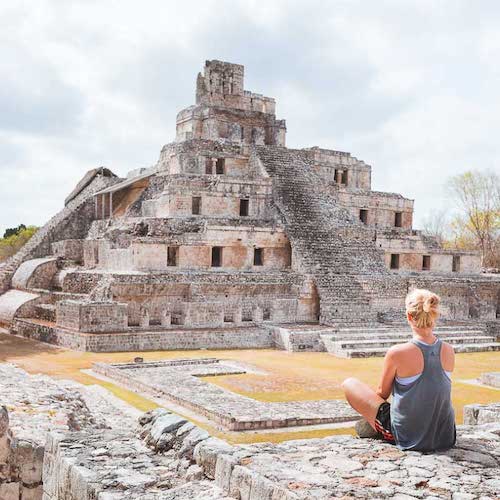
The oldest evidence of the Mayan culture in Campeche, apart from ceramic remains, has been found from the year 150 AD. to 250 AD in Becán and in Calakmul. However, there are also stelae in El Palmar and Edzná that establish dates of 337 AD. to 435 AD. The Mayans of Campeche built magnificent architectural works. The centers of the cities were filled with foundations for the temples, palaces, ball courts, astronomical observatories and rooms; like those seen in the Campeche Petén, the Puuc region, that of Los Chenes, that of Río Bec and that of the rivers and lagoons.
The artistic achievements of this civilization were manifested through fine ornamental pieces, manufactured in jade, shell, alabaster, obsidian and bone; An example of this are the pieces from the tombs of Calakmul. The beautiful terracotta figures of Jaina that evoke aspects of the daily life of the society and the exquisite polychrome vessels, show us the skill of its potters. The sculpture used in the decoration of the buildings and the detailed works in the stuccoed frieze of Balakmú, the masks of Edzná and El Tigre, are irrefutable proof of the skill of the craftsmen.
The celestial bodies, especially the Sun, made the Mayan man know the march of the seasons, the cardinal quadrants and the concept of time, which they measured with an extremely precise calendar. Like those of other regions of the Mayan world, the inhabitants of Campeche had a main deity, Itzamná, and others such as Yum Chaac, lord of the rain; Ixchel, goddess of the moon; Ah Puch, god of death; Kinich Ahau, god of the sun; Ek Chuah, god of war, among others.
The Mayans also practiced war, which is why there are cities in Campeche with remains of walls, such as Calakmul and Becán, which has a defensive moat. Between the year 1000 A.D. and 1540 A.D., the structure of Mayan society undergoes strong changes, and the culture undergoes transformations that affect the typical forms of pottery, which becomes coarse, as well as stonework and the architecture of some cities, including Tiger.
The Mayans of Campeche left evidence that specialists have classified into four architectural styles: Petén, Río Belec, Chenes and Puuc, samples of that splendid past that arouses the amazement of all visitors.
Calakmul
The place has 6750 structures, which includes the highest pyramid on Mexico and The Great Square. Located in the heart of a beautiful biosphere reserve, this ancient Mayan city developed in several stages, during which it consolidated as an important city that politically dominated a wide region of the Petén. Probably between 350 and 750 AD.
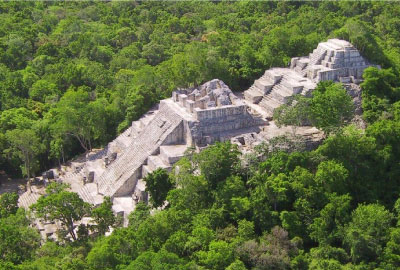
It allied itself with cities from the Usumacinta basin against Tikal and later with groups from the Río Bec area, in a new boom that lasted approximately until the year 1000 AD. The cultural influence of Tikal and Río Bec is manifested in a good number of their structures.
The city was about 70 square kilometers in size and so far more than 6,000 structures have been located, including plazas, ceremonial complexes,
and residential and administrative areas. The Great Plaza stands out, with its imposing Structure II, which is one of the largest in the Mayan area, reaching a height of almost 45 meters; in that same square are structures IV, V and VI, the first and last with interesting astronomical markers; structures VII and VIII, which are related bases, and structure XV, where funerary chambers of various important figures have been found, possibly former rulers of the city.
In the Great Acropolis there is another set of buildings around squares and patios, where the ball court is also located and where a large number of stelae have been found.
It is considered an elitist center of the region, due to the elegance and ornamental wealth of its buildigs; it is a mixture of Chenes and Rio Bec style. The Structure II is one of the most beautiful buildings in the region. Its name means “the house of the mouth of the serpent”. Chicanná was an important city in the Río Bec region, dependent on Becán, which developed from the year 300 BC, reaching its peak between 550 and 700 AD, although it remained occupied until the year 1000. On the site there are several buildings around a central plaza, such as structures I and II.
The first is a rectangular building with rooms in the center and flanked by two rounded corner towers, with stairways and simulated temples that had masks of the rain god; and the second is one of the most beautiful buildings in the region, as its façade is richly decorated in the purest Río Bec style, with motifs that resemble a huge figurehead of the god Itzamná, whose open jaws frame the door of the enclosure.
A few meters from the main complex is Structure VI, which was part of an old patio and another series of residences. Its openwork cresting and its facade adorned with masks in profile of the god that water grants are striking.
Edzná
The Main Square is a wide quadrangular space, and the principal five stories building is a unique structure in the Maya world. The investigations carried out on the site reveal that it had human occupation since at least 600 BC. and until 900-1000 AD. The first groups settled in the place attracted by the numerous watering holes that were in the valley, which led to a rapid evolution that would reach its golden age between 500 and 900 AD.
It is considered that the city came to occupy an approximate area of 25 square kilometers and to date a little more than 200 structures have been located, including foundations, platforms, buildings and housing complexes, of which the constructions that are around have been explored. of the Great Plaza, such as the Great Acropolis, the Platform of the Knives, the Annex of the Knives, the Casa Grande or Noholná, a sacbé or white path, a ball court, a group of temples to the south of the Great Plaza and the Small Acropolis, among others.
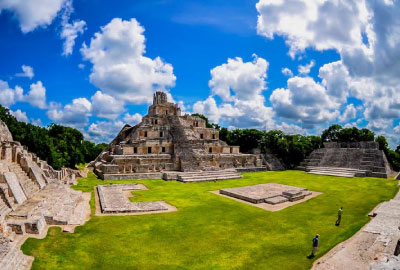
Some of these buildings show architectural features of the Puuc and Chenes styles. The Great Acropolis is perhaps the most representative set of the site; It is a large elevated platform with a quadrangular plan, on which some eleven or twelve structures were erected. The general style of the set shows a great cultural influence from the Guatemalan Petén. The Casa Grande or Noholná closes off the Great Plaza on its west side. It is an elongated structure that has a large staircase on its main façade, which opens along the length of the building.
Some scholars have thought that it is about stands, which perhaps served to house the public that witnessed the ceremonies held in the square.
In the Small Acropolis there is also an elevated quadrangular platform, with four buildings, in which architectural features of the Puuc style can be seen; one of the structures has a staircase in which glyphs with geometric, animal and human images can be distinguished.
In the temples of the southern part, two magnificent stucco masks were found, adorning the sides of a structure, representing the solar deity Kinich Ahau in his dedications as the star of sunrise and sunset.
In Edzná, important data was also found about a complex network of hydraulic canals that served to irrigate the valley, an aspect that had an important effect on the productive capacity of its lands and on the development of the city.
The most important building is the Temple-Palace, which is a 76 meter long platform by 30 meter wide, with a Rio Bec style. With an area of almost 1.4 square kilometers, this site is of great interest due to the beautiful buildings that it still preserves, silent witnesses of its greatness, which must have happened between the years 600 and 800 of our era, although it is known that the site was occupied from more remote times, probably around 600 B.C.
The place is located in the region known as Los Chenes, and during its best period it had a sequence of pyramidal bases with ceremonial buildings and surrounding housing complexes. Currently, only the only explored structure can be visited, and it is known as Structure A1, which consists of a large elongated platform on which three towers stand in the purest Río Bec style.
Chunhuhub
The buildings are characterized by the harmonic combination of chiaroscuros on their facades. A good example is the “Palacio” and the Structure II. This site is believed to have had its heyday between 600 and 800 AD. These are two rectangular structures that were probably related to a square. The building called El Palacio or Structure I has two levels with thirteen rooms, inside which the typical Mayan-style vaults can be seen.
Both structures show interesting decorations on their facades based on small columns attached to the walls and sets of frets and friezes, all elements that belong to the Puuc style and that occur in this place due to its geographical proximity to the places where that style was developed in the neighboring state of Yucatan.
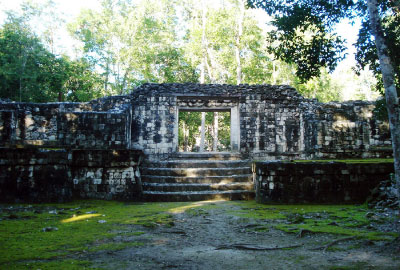
It is integrated within 3 architectural groups, and its main feature are the stucco sculptures. Nestled in the jungle of southern Campeche, and whose name means “Jaguar Temple”, Balamkú probably had its heyday between 500 and 650 AD. It consists of three architectural groups that occupy an approximate area of one square kilometer, the most important being the Central and the South.
In the first, Structure I stands out, with a substructure that has a magnificent frieze made of stucco, with masks of the monster of the earth and aquatic animals. The South Group is very small, with four squares and a pyramid whose upper part has a temple with the remains of stucco images.
The architecture shows interesting features of the Río Bec style and artistic influences of the Petén style. Be sure to go to Balamkú, where you can admire the frieze of Substructure I-A that shows a crocodile accompanied by aquatic plants, emblems of the humid and fertile land and that represent the transition between two worlds.
Hormiguero
The Structure II is the most important building, located on the South Group. Central Group houses Structure V and VI. Belonging to the group of cities in the Río Bec region, this site had its heyday between 600 and 800 AD.
Its main attraction is the building known as Structure II, built with the peculiar architectural style of the area. The cover shows its typical zoomorphic mask with open jaws, in a display of great beauty.
In the northern section of the site, Structure VI can be visited, flanked by two towers of the same architectural style, and Structure V, with a portal that is also zoomorphic and side decorations based on masks of the god Chaac.
Square A proudly shows the great Structure I with its two solid 15 meter high towers. In Square B, the Structure IX, a 32 meter tall building, and X with frets and masks of god Itzamná. The Ball game is located on Square C.
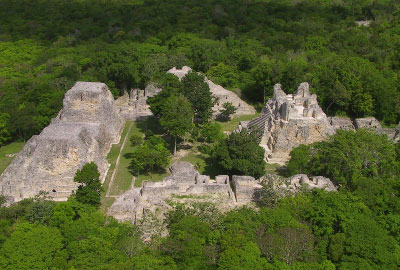
Important Mayan city occupied since 600 BC. like an incipient village; It had its moment of splendor between the years 550 and 850 AD, a time when it was consolidated as a city that controlled a large territorial extension. Its ceremonial center is surrounded by a large moat 1.9 km long, which has been speculated to have had a defensive function, although some specialists have pointed out that it is likely that it delimited the main area of the site, occupied by the ruling elite, where They built most of the buildings that can be seen today.
The general architectural style is Río Bec, which presents pyramidal structures with lateral towers, profuse ornamentation of fretwork and large masks of the god Itzamná. The moat is interesting, with its seven entrances; structure IV, which shows a beautiful ornamentation on its façade and a complicated distribution of corridors that seems to form a labyrinth; structure IX, 32 meters high, and the small ball court in the West Plaza. Other relevant architectural complexes are structures VIII and the buildings in the western sector of the West Plaza itself.
The archaeological landscape of this area is one of the most impressive and beautiful, not only in Mesoamerica but in the whole world. Becán means “Ravine” in Mayan. Near Becán there are other archaeological zones whose visit is really recommended, among them Xpujil and Chicanná stand out
for their magnificent architecture.
Kankí
This site is comprised by: the North Group, the Group of the Little Toad or Cacabbeec, and the Central Group with 10 courts, a number of chultunes, low platforms and The Palace. Other important structures are The Vault of Inverse Stair and the Contiguous Columns. Site of clear Puuc style. It has a series of structures organized around patios arranged on several levels and connected to each other.
One of the most outstanding buildings for its architecture and decoration is the so-called Palace, which is a two-level construction with rooms and interesting ornamental details, such as frets, friezes with reliefs and masks of the god Chaac. Two more groups, called Grupo Norte and Grupo del Sapito, bring together others from buildings where vestiges have been found that have allowed part of the history of this site to be deciphered.
It is comprised of seventeen groups of temples and family residences dispersed over five square km. Hochob – This site clearly shows the Chenes style it contains a complex of buildings to form a ceremonial center.This site corresponds to the group of small cities that developed within the Río Bec style; It was occupied between 400 B.C. and 1200 AD, although its heyday has been between 750 and 900 AD.
The site is small, it consists of four groups of buildings, of which you can visit the so-called Group I, made up of a large structure whose façade rises facing east, with three high towers of superimposed bodies. The entrances of the building display groups of zoomorphic masks, which are repeated on the simulated stairs of the towers and are complemented by another large mask that represents the monster of the earth with open jaws.
It was the most important political entity of the Chenes Region. The main buildings are: The Palace, with 44 rooms and the Snake Mouth Building. Xtampac means “Old Walls” in Mayan, and it is known that this important center probably had its first inhabitants around 300 BC, reaching its golden age between 600 and 800 AD, when it emerged as the political center of the Los Angeles region, Chenes.
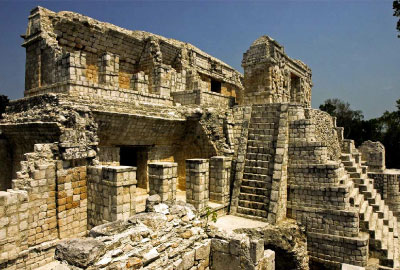
The core of the site was built on a natural elevation that was conditioned to build some groups of buildings, mainly of a ceremonial nature, that occupy an area close to 9 square kilometers.
Among the outstanding buildings is El Palacio, today partially demolished and perhaps the most imposing on the site, with three levels in which 44 rooms are distributed and a curious arrangement of stairs with part of them inside the structure, a very rare aspect in the region.
Another building has a spectacular Chenes-style façade, where you can see a unique serpent figurehead that opens its jaws to frame the access door, surrounded in turn by some Puuc-style decorative features.
The Casa Colorada and its Annex, which form a kind of alley and have a series of rooms; The Barracks, with buildings on its four sides that show wide access stairs, and the Southeast Quadrangle, also surrounded by buildings on its four ends and forming a ritual square with a small shrine in the center.
Tabasqueño
It has a rectangular square delimited by several buldings. The period of splendor of this place is between the years 750 and 900 AD. The site is made up of a large rectangular plaza surrounded by four buildings in the Chenes architectural style. Structure I stands out, a building with eight rooms and an access staircase, which on its main façade boasts a superb zoomorphic mask surrounded by masks of the monster of the earth and framed by representations of the mask of the god Chaac, the whole set beautifully topped by a high cresting.
Near this building is the so-called “emblem tower” of the site, a structure just over three meters high that resembles a huge unadorned crest. The recording of equinoxes and solstices, as well as the movement of the sun during the day, are among its possible astronomical functions.
Isla de Jaina
Within the coastline of the Los Petenes Biosphere Reserve there are two islands that in ancient times served as Mayan necropolises. Both are separated by 15 kilometers and were occupied around the Late Classic. In Isla de Piedra, not only graves were found, but also ceramic, basalt, obsidian, flint and calcareous stone objects.
Larger and more studied is the Island of Jaina filled with amazement at the clay figurines that were found, accompanied by funerary offerings. Men and women, flaunting gestures, postures and outfits, were portrayed by the hands of the potters.
Also striking are the sculptures of dapper characters that emerge from long-stemmed flowers. Both in the Archaeological Museum of the Fort of San Miguel in the city of Campeche, and in the Archaeological Museum of Hecelchakán, figurines and clay pieces from the Island of Jaina can be found on display.
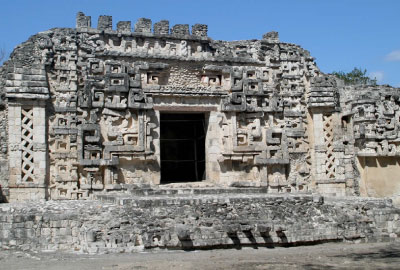
Interesting site dating from around 100 AD. and that it developed steadily until around 1100 AD. The site was built on an artificial elevation that reaches about 30 meters above the surrounding land, to contain a group of buildings that formed what was apparently the ceremonial center. The East Palace, the Main Palace and other nearby structures formed by buildings on low-rise platforms are grouped around three squares of regular size.
The facades of the buildings in general show a profuse decoration in the purest Chenes style, based on large and small stone blocks perfectly arranged to form emotional masks of the god Itzamná, whose threatening open jaws announce the entrance to the buildings that surely housed temples, chambers and priestly chambers. Another of the structures shows the typical layout of the regional style, with two large towers that are adorned with simulated staircases, flanking the central entrance of the building.
Jaina
Mayan necropoly from the classic period. Main architectonic complexes are Zayosal and Zacpool. One of the most interesting sites in the region mainly due to its fame as a Mayan necropolis. The site was developed during the Classic period, between 300 and 900 AD. It consists of two complexes of pyramidal structures and other small buildings that are distributed to the northwest and southeast of the islet. The first has been called the Zayosal Complex and the second the Zacpool Complex.
Both show a series of pyramidal buildings, plinths, housing complexes, patios and plazas. A little more than a thousand human burials have been explored in the surroundings of these architectural complexes, in which extraordinary pieces of clay have been found that were possibly deposited as mortuary offerings. These pieces, at the time, determined a new way of appreciating Mayan art made of clay, since its quality far exceeded what had been found until then in other sites in the area.
It has been said that this site, due to its size and number of structures, could be the ancient city of Itzamkanac, capital of the province of Acalan. The place is located on the banks of the Candelaria River and developed significantly towards the Postclassic period, around 700 to 1400 AD.
It consists of a central square with large pyramidal bases around it. The buildings had stucco coatings and mural paintings and retain some architectural similarity to structures in central Mexico. Around the central plaza there are several sets of mounds arranged around plazas and patios of various sizes.
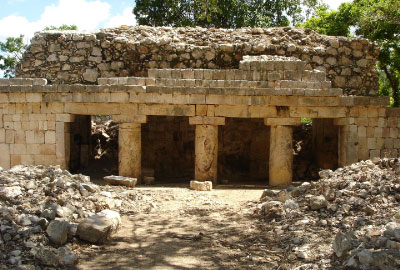
The explorations carried out on this site indicate that it had its peak between the years 730 and 850 AD. It could have been a regional capital that controlled about twenty-five cities or small towns that existed in its surroundings during the time.
Its architecture is fundamentally in the Puuc style; among the explored ensembles, the Palacio de los Cilindros stands out, which is a building with ten rooms on whose façade the typical decorative columns of the aforementioned style can be seen
The building of the Initial Series, so called because inside it was found a date with an initial series that dates back to the year 700 AD, it has three rooms and had monolithic columns and lintels that today are found in the archaeological museum of the city of Campeche
And finally, the building called Casa del Gran Lintel, which boasts a huge monolithic lintel carved with images of richly dressed characters, faces and numerals.
This site was discovered when federal highway 261 was being built in the eighties of the 20th century. This site saw its apogee in the Late Classic and the Chenes and Puuc styles were mixed there. It is known by the name of Tacoh; “ta” means “flint knife” in Mayan; “coh” which means “precious thing”; or Tohcok for the beautiful bird “toh” also called clock bird or momoto that lives in the area. Only two of the ten scattered buildings have been intervened, structures I and II.
The first is a palatial construction that used to have two levels. It measures 20 meters long and has refused to let time take away the things that were given to it following the Puuc taste, monolithic columns, capitals and lintels. The II was restored by the archaeologist Antonio Benavides and it is a palace with a terrace that served both to observe the solar movements and to accommodate sacrifices.
Its lower part still preserves remains of a frieze. Behind there are two single-point arches, they were the side entrances to the complex and they were also decorated with friezes. In one of them you can see lilies and ears of corn with a human head emerging.
Map of Archaeological Sites in CAMPECHE
More Tourist Attractions in CAMPECHE
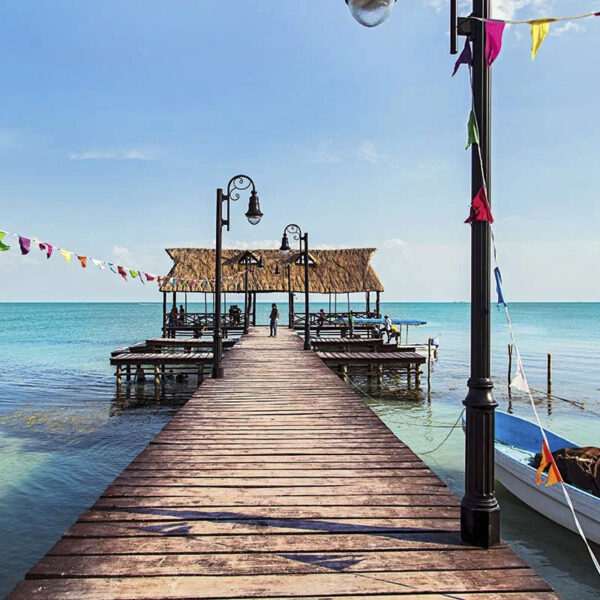
Campeche City Surroundings
Campeche is one of the states in the Mexican southeast that is worth visiting for its charming corners full of nature and cultural richness. Therefore, on this occasion, we present some of the most striking interesting sites in Campeche that will surely leave you speechless on your next trip. Take the best photos, fall in love with the best views, let yourself be surprised by its little towns full of history and learn more about the richness of this place.… Read More
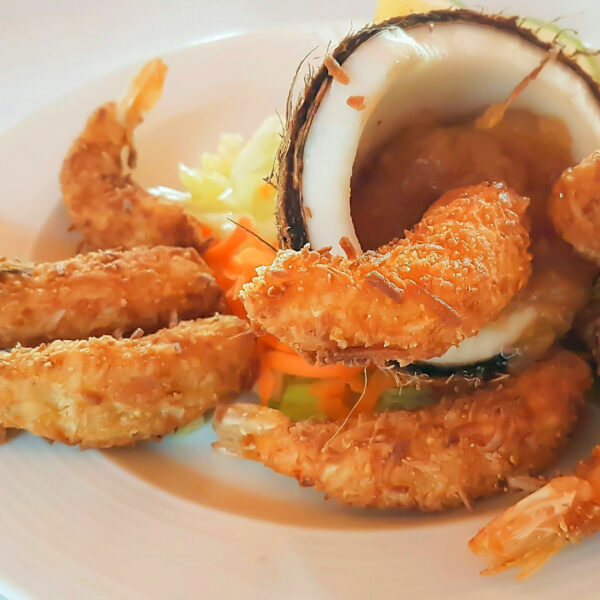
Gastronomy of Campeche
The state of Campeche is famous for its excellent gastronomy, unique and original for its creativity, seasoning and taste. Its gastronomic personality is the result of its Mayan heritage, combined with the contributions of the Spanish, and even pirates and corsairs also brought new components and forms of preparation in the various dishes that can be savored in the region today. Campeche has a wide variety of seafood, which has been fully used in its cuisine.… Read More
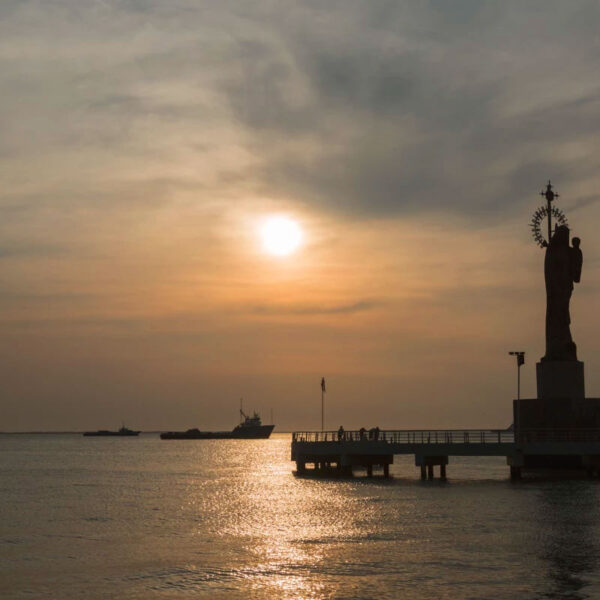
Ciudad del Carmen
It was founded during the pre-Hispanic period, and after the arrival of the Spaniards the island was populated mainly by pirates, it was known as
“Isla de Tris”. Cd. del Carmen has an extension of 6,353.3 square miles and is surrounded by beautiful landscapes with tropical vegetation. Also known as the Pearl of the Gulf, the island lies off the coast and is connected to the mainland by two bridges over the Laguna de Terminos, one of them with a length of more than two miles is the longest in Mexico. The natural attractions along with the archeological sites and the European style buildings in town, convert the island in a very apealing place for visitors.… Read More
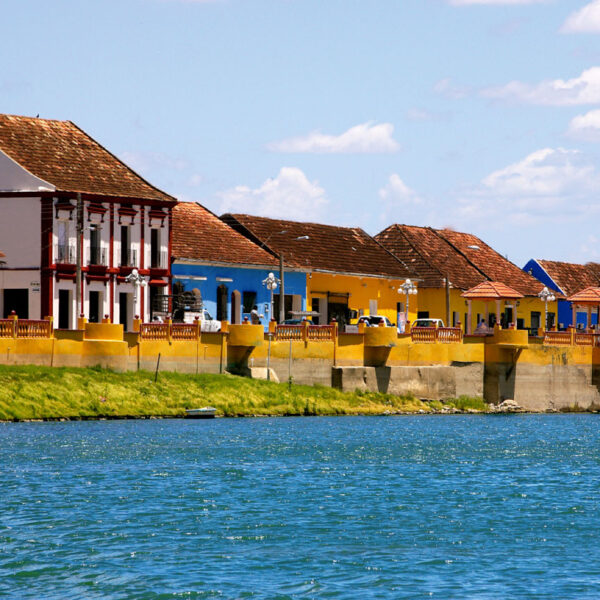
Magical Towns in Campeche
Among all the wonders of the state, there are also two of its magical towns: Isla Aguada and Palizada. Two ideal destinations to live under the colors of the sunsets, the beauty of its architecture and the legends of its streets.… Read More
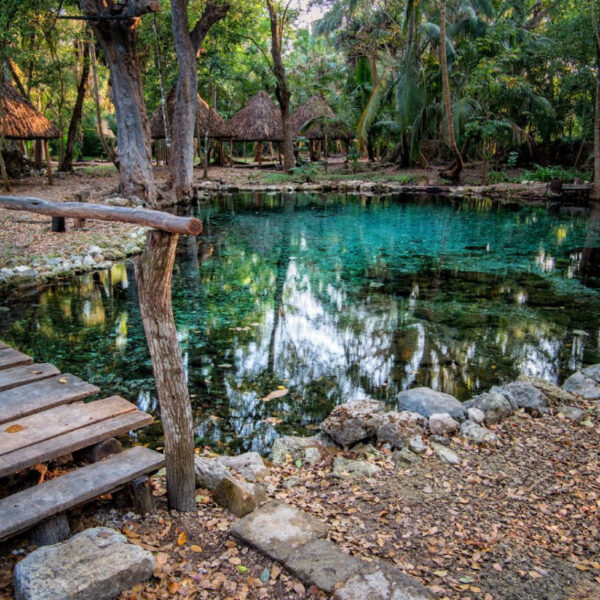
Ecotourism and Adventure in Campeche
Ecotourism in Campeche is lived between majestic jungles and mangroves, fill your vacations with unforgettable adventures! If you are looking to reconnect with nature and live it to the fullest, you will love ecotourism in Campeche. Get ready to go through jungles surrounded by tropical jungle and Mayan culture, mangroves and petenes surrounded by rich wildlife.… Read More
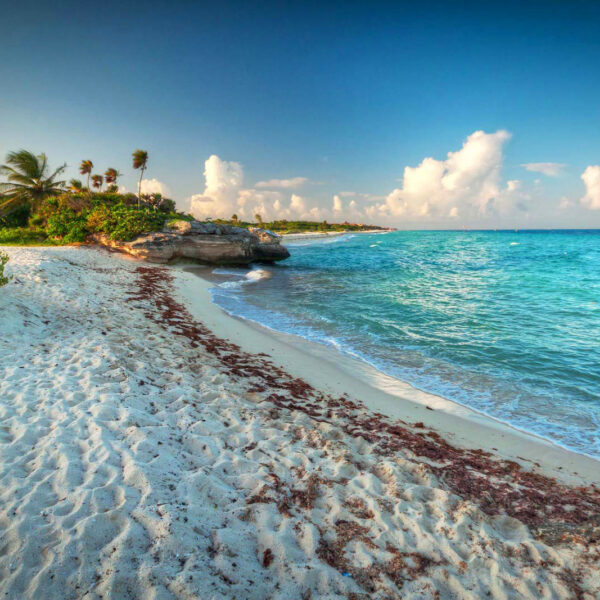
Beaches in Campeche
Thanks to the natural beauty that surrounds them, and the low presence of tourism, the state has some of the most beautiful beaches in Mexico. Its sand, which ranges from golden to white, and the tranquility of its sea, are oases away from the big cities and crowds, where you can relax and enjoy nature.… Read More
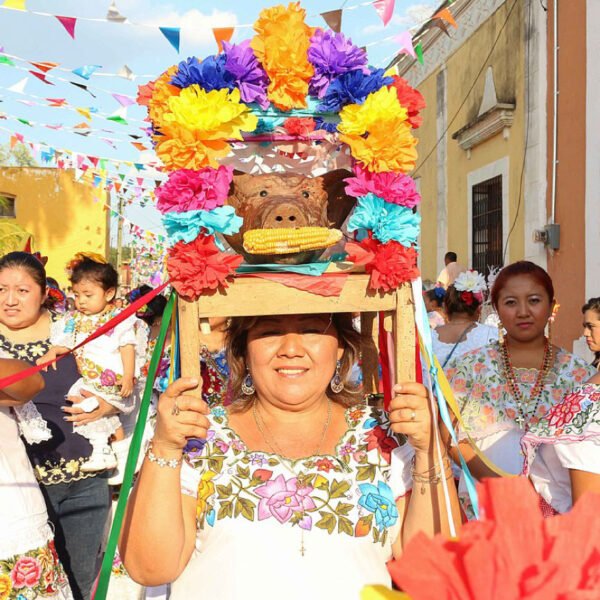
Traditions of Campeche
Campeche is without a doubt one of the most beautiful and traditional States of Mexico. Campeche is located in the southeast of Mexico and borders the states of Yucatan to the north, the state of Quintana Roo to the east, and the countries of Guatemala and Belize to the south. The capital of this State is called San Francisco de Campeche and it is also the city with the largest population in Campeche.… Read More
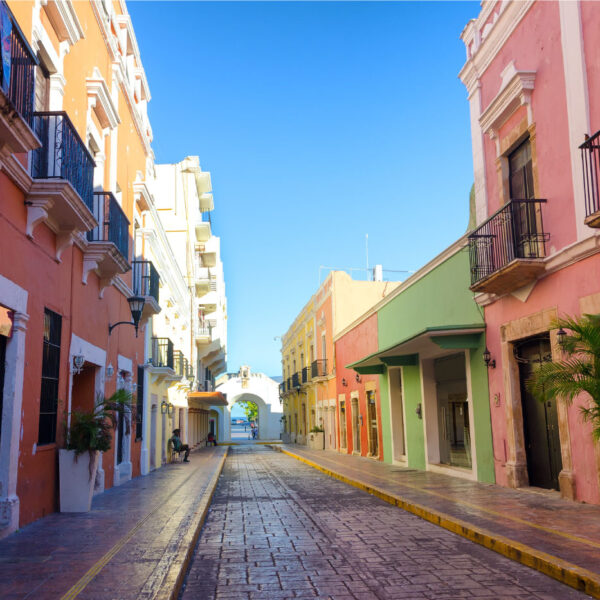
Campeche City
Campeche is a city immersed in the typically colonial atmosphere with towers, bastions and walls. The state of preservation and quality of its architecture earned it the status of a UNESCO World Heritage Site in 1999.… Read More
Flights & Hotels in CAMPECHE
More Tourist Attractions in MEXICO

Gastronomy
The Gastronomy of Mexico has a great diversity of typical dishes, which is why it was recognized by UNESCO as Intangible Heritage of Humanity. The basic and representative ingredients of Mexican dishes are: corn, coriander, chili, beans, piloncillo, nopal and tomato. Mexican cuisine is also characterized by its sauces, which serve as an accompaniment to traditional dishes, prepared based on spices.… Read More

Archaeological Sites
The Archaeological Zones are the cultural past of every Mexican. You will be amazed at the ambient, nature and the environment that surrounds them. Climbing to the top or being around it will take us back in time to admire every detail. México is a country of culture and traditions, many of which we have inherited from the pre-Hispanic inhabitants of this vast territory, although it is true that there were more settlements in the central and southern part of the country, it is also possible to find some archaeological remains in the north.
… Read More

Magical Towns
A Magical Town is a place with symbols and legends, towns with history that in many cases have been the scene of transcendent events for our country, they are places that show the national identity in each of its corners, with a magic that emanates from its attractions ; visiting them is an opportunity to discover the charm of Mexico. The Magical Towns Program contributes to revalue a set of populations in the country that have always been in the collective imagination of the nation and that represent fresh and varied alternatives for national and foreign visitors. A town that through time and in the face of modernity, has conserved, valued and defended its historical, cultural and natural heritage; and manifests it in various expressions through its tangible and intangible heritage. A Magical Town is a town that has unique, symbolic attributes, authentic stories, transcendent events, everyday life, which means a great opportunity for tourist use, taking into account the motivations and needs of travelers.… Read More

Traditions in Mexico
It is practically impossible to make a meticulous, and above all, accurate selection of the places to visit in Mexico. Each place that our country houses is unique and beautiful in its own way. Mexico, with its nearly 2 million km², has a large number of scenarios to offer, as well as endless activities to do. Do not lose your way and enter the places to visit in Mexico. In Mexico, apart from the beaches and its famous archaeological sites, there are many other really interesting sites and activities that you should know. In the surroundings of the main cities you will find places full of culture and tradition, where you can spend relaxing, interesting and fun vacations. On your trip through Mexico you cannot stop obtaining souvenirs, the crafts that are made here are of the highest quality and recognized worldwide. A shopping tour cannot be missed.… Read More

Beaches
On the Beaches of Mexico you can immerse yourself in the intense blue ocean of the Pacific bays, sunbathe on the shore of the warm and transparent waves of the Caribbean Sea in Quintana Roo or even rest on the beautiful coasts of the Gulf of Mexico. Mexican beaches hide wonderful secrets for the traveler. By visiting them, in addition to enjoying the excellent climate and water activities, you can discover splendid archaeological sites and interesting colonial cities without traveling long distances.… Read More

Ecotourism and Adventure
Mexico is one of the best countries for Ecotourism as it has a great variety of flora and fauna, as well as a large number of refuges for extraordinary species. You can enjoy recreational activities of appreciation and knowledge of nature through contact with it, such as: stargazing, observation of natural attractions, wildlife and bird watching. Throughout México there are more than 176 protected natural areas, 5 of them considered by UNESCO as Natural Heritage of Humanity. Just for this and much more, we believe that Mexico is a Paradise for Ecotourism.… Read More

Capital Cities
Folklore, gastronomy, literary culture, art and exhibitions, is what you will find in the capitals of the states of Mexico. To the north, colonial Mexico, Puebla, Guadalajara, Guanajuato, the Sonoran desert and the California peninsula. To the east Veracruz and the gulf. To the west Acapulco, Oaxaca and Tuxtla Gutiérrez. And to the south the Riviera Maya and the pyramids of Chichén-Itzá, Tulúm and Cobá in Yucatán, Palenque in Chiapas, the cenotes, and the Central American jungles.… Read More

States Of Mexico
Mexico has an incredible diversity of landscapes, where the beauty of its beaches, internationally recognized, stands out. In its vast territory of coasts, there are beaches of unparalleled beauty, and colorful landscapes. A large network of first-class hotels and tourist services is available to visitors to these beaches. Mexico is also mystical places, dotted with archaeological testimonies inherited from its original inhabitants. Monuments made by the Mayas, Aztecs and Toltecs are located in magical landscapes, like lighthouses in an ocean of natural beauty. They offer visitors buildings that tell their history, and museums that collect their cultural heritage. And that keep alive ancestral traditions, in ceremonies and festivals, where you can enjoy cultural activities and entertainment.… Read More

